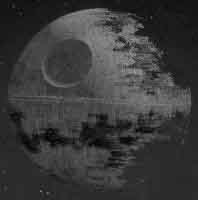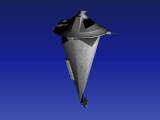Death Star I and II and other superweapons


 Even with his enormous Imperial space fleet in place, Palpatine felt that there was a certain lack of"respect" (and fear) for his rule among the worlds of the former Republic. Wanting to remedy the situation, he called upon the brightest of his spacecraft designers and demanded a vessel more magnificent and more powerful than any that had ever been in space before. His single demand was that the new battle fortress have the ability to destroy an entire planet with one quick, massive stroke, against which there could be no planetary defence.
Even with his enormous Imperial space fleet in place, Palpatine felt that there was a certain lack of"respect" (and fear) for his rule among the worlds of the former Republic. Wanting to remedy the situation, he called upon the brightest of his spacecraft designers and demanded a vessel more magnificent and more powerful than any that had ever been in space before. His single demand was that the new battle fortress have the ability to destroy an entire planet with one quick, massive stroke, against which there could be no planetary defence.
The Imperial code name for the project became Death Star. A new, frighteningly powerful superlaser system was created, one which required an energy supply so huge that it demanded, in essence, an artificial planetoid to house it. All Imperial estimates showed that a single blast from the Death Star's cannon would equal the combined firepower of the entire Imperial fleet, and the Emperor, pleased with the concept, ordered construction to begin.
An unoccupied and isolated sector of space was chosen as the construction site. For nearly two years, every resource of the Empire was directed toward the completion of the project. Grand Moff Tarkin, a former governor of one of the outlying territories, had served as project supervisor of the battle station and was awarded command of the Death Star once it was complete. This brilliant strategist used the power of the Death Star to increase his own political influence for the duration of his commend.
At the core of the Death Star was an immense, cavernous housing for the battle station's power generator matrix. A fusion reactor of incredible proportions, fed by stellar fuel bottles lining its periphery, produced the raw energy demanded by the Death Star's superlaser and hyperdrive systems. Much of the station's interior volume was filled by the machinery necessary to sustain such a fusion core, with sublight propulsion systems and defuse field generators lining the outer equatorial regions. Realspace propulsion was handled by an external array of powerful ion engines, which converted the raw fusion energy of the station's core into thrust and pressed the station's great mass into any motion dictated by the Death Star's huge navicomputer banks. While ion engines of such magnitude are highly radioactive, no other system could provide the directional control necessary for a station of such great size. Engineering personnel assigned to monitor ion vent operations usually wore radiation suits.
The Death Star's hyperspace motivator units were comprised of linked banks of field generators such as those found aboard Imperial Star Destrovers. One hundred twenty-three individual hyperspace generators, tied into a single navigational matrix, were necessary to carry the Death Star beyond the speed of light. The intense power generated within the battle station, combined with its great mass, gave it both magnetic and artifical gravitational fields equal to those of a natural body many times its size.
At the true equator of the station was a deep trench, encircling the Death Star like a straight, endless canyon some 376 kilometers in length. Here were housed the station's primary hangar bays, drive thrusters, heat exhausts, primary sensor arrays and tractor beam systems. Lining this trench were thousands of turbolaser turrets for defense against starfighter attack, for while the Death Star was impervious to large vessel onslaughts there were "seams" in the station's defensive shields that a small fighter could exploit.
The Death Star's superlaser cannon was once thought to be beyond the capability of Imperial military science. Its faceted amplification crystal combined and intensified eight separate initiator beams into a single laser with all the intensity of a stellar-core; the impact of this beam could be controlled and scaled to suit the destruction of any target. A beam of one power level was used against enemy capital ships, while a much greater laser could cause the fracturing and disintegration of a target planet. The superlaser's power had to be recharged between firings and the intensity of each firing determined how many times per day the weapon could be used (from once per minute against spaceborne vessels to once per day against planetary targets). The pinpoint focus necessary for the combining of the superlaser's eight component beams limits its range to planetary distances.
At 120 kilometers in diameter, the Death Star was the single largest object ever built. Its officers and crew served within a self-sustaining world, complete with leisure resources and private living communities. Parks, shopping centers and entertainment establishments were provided for those aboard the station, for their terms of service were generally to average six years with no outside shore leave. The operation of the Death Star required a full crew of 774,576, overseen by a staff of 27,048 officers. In addition to this, 378,685 support and maintenance personnel were necessary. Security aboard the station was maintained by a force of more than 25,000 stormtroopers.
In addition to the humanoid crew of station, the Death Star had a support "crew" of more than 400,000 droids. These robotic servants range from sophisticated R2 units to "mouse" droids and fill a variety of roles, including: protocol, translation, interrogation, scientific research, medical assistance, domestic service, local transportation and sanitation.
The station's surface was covered with hundreds of thousands of "city sprawls," manned stations dedicated primarily to defence. Here were found the majority of the Death Star's shield projectors and communications arrays. While the interior decks of the station were designed and built with artificial gravity dedicated to the poles (i.e., north was "up," while south was "down"), the personnel of the outer surface sprawls were planetary nature (i.e., the Death Star Core was "down").
At the exact north "pole" of the station was a tower (the single most highly shielded object on the surface) which was impervious to outside attack. At the top of this 100-story tower was the Emperor's private observation chamber and command post, from which Palpatine could oversee all Death Star operations. The first Death Star was destroyed before the Emperor ever set foot on board, but the tower that rose above the second Death Star was personally manned by Palpatine during the Battle of Endor. Palpatine died there, just prior to the destruction of Death Star II.

 The deadliest weapon ever known, little information is available to the public about this starship. The Sun Crusher was designed in the Black Maw Installation by Qwi Xux (a traitor now), and her fellow companions. They were supervised by the heroine Admiral Daala who, at the time, commanded four Imperial Star Destroyers. The way into the Maw station was guarded by a series of Black Holes. Only Daala knew the hyperspace route through the holes, and she was strict about whom she gave this information to. It has been said that she gave incorrect coordinates to a supply ship which unexpectedly was sucked in by the unforgiving jaws of a Black Hole.
The deadliest weapon ever known, little information is available to the public about this starship. The Sun Crusher was designed in the Black Maw Installation by Qwi Xux (a traitor now), and her fellow companions. They were supervised by the heroine Admiral Daala who, at the time, commanded four Imperial Star Destroyers. The way into the Maw station was guarded by a series of Black Holes. Only Daala knew the hyperspace route through the holes, and she was strict about whom she gave this information to. It has been said that she gave incorrect coordinates to a supply ship which unexpectedly was sucked in by the unforgiving jaws of a Black Hole.
It has a smooth conical hull with a rounded top which is coated in a thick layer of atoms, pressed together as close as the laws of physics allow. This armour is essentially impenetrable, not even a nuclear bomb could explode this thing. The only areas left unprotected were the four small turrets, mounted on the cap of the cone.
This craft is very nimble and can attain high speeds in short times. It is very maneuverable, an engineering feat considering the shape of the ship. It was designed for hit and run attacks on solar systems, which brings me to another point.
The Sun Crusher was designed to live up to its name. At the tip of the cone there is a warhead launcher. This would fire a special torpedo that could withstand the heat of any sun and penetrate the core. What resulted was a massive supernova, about an hour later. This destroyed all things within the solar system, but thankfully, the Sun Crusher had hyperdrive to escape the devastating explosion.
It was captured after former prisoners Han Solo, Kyp Durron, Chewbacca and Qwi Xux, took control of it and rammed it through the hangar of one of Admiral Daala's Imperial Star Destroyers. They somehow managed to pilot their way through the Black Holes and escape to Coruscant.
Kyp Durron went on a rampage and then triggered at least four supernovas, all in Imperial space. This included the planet of Carida which served as the Empire's primary source of stormtroopers. The Sun Crusher worked its way back to the Black Maw Installation and was sucked into a black hole just before the prototype Death Star followed it.